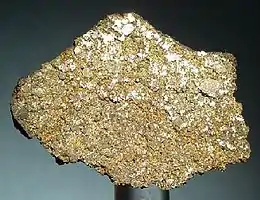Tetrataenite
Tetrataenite is a native metal composed of chemically-ordered L10-type FeNi, recognized as a mineral in 1980.[4][5] The mineral is named after its tetragonal crystal structure and its relation to the iron-nickel alloy, taenite.[6] It is one of the mineral phases found in meteoric iron.[7][2][8]
| Tetrataenite | |
|---|---|
 Silvery-bright tetrataenite crystals | |
| General | |
| Category | Native element minerals |
| Formula (repeating unit) | FeNi |
| Strunz classification | 1.AE.10 |
| Crystal system | Tetragonal |
| Crystal class | Domatic (m) (same H-M symbol) |
| Space group | Pm |
| Unit cell | 22.92 ų |
| Identification | |
| Formula mass | 57.27 gm |
| Color | gray white, silver white |
| Crystal habit | Granular - Common texture observed in granite and other igneous rock |
| Cleavage | none |
| Fracture | malleable |
| Mohs scale hardness | 3.5 |
| Luster | metallic |
| Streak | gray |
| Diaphaneity | opaque |
| Density | 8.275 |
| Common impurities | Co,Cu,P |
| References | [1][2][3] |
Formation
Tetrataenite forms naturally in iron meteorites that contain taenite that are slow-cooled at a rate of a few degrees per million years, which allows for ordering of the Fe and Ni atoms.[9][10] It is found most abundantly in slow-cooled chondrite meteorites,[11] as well as in mesosiderites.[9] At high (as much as 52%) Ni content and temperatures below 320 °C (the order-disorder transition temperature), tetrataenite is broken down from taenite and distorts its face centered cubic crystal structure to form the tetragonal L10 structure.[12][10]
The L10 phase can be synthetically produced by neutron- or electron-irradiation of FeNi below 593 K or by hydrogen-reduction of nanometric NiFe2O4, but only on a small scale.[10]
In 2015, it was reported that tetrataenite was found in a terrestrial rock - a magnetite body from the Indo-Myanmar ranges of northeast India.[10]
Crystal Structure
Tetrataenite has a highly ordered crystal structure,[12] appearing creamy in color and displaying optical anisotropy.[13] Its appearance is distinguishable from taenite, which is dark gray with low reflectivity.[10] FeNi easily forms into a cubic crystal structure, but does not have magnetic anisotropy in this form. Three variants of the L10 tetragonal crystal structure have been found, as chemical ordering can occur along any of the three axes.[4]
Magnetic Properties
Tetrataenite displays permanent magnetization, in particular, high coercivity.[5] It has a theoretical magnetic energy product, the maximum amount of magnetic energy stored, over 335 kJ m−3.[5]
Applications
Tetrataenite is a candidate for replacing rare-earth permanent magnets such as samarium and neodymium since both iron and nickel are earth-abundant and inexpensive.[14]
See also
References
- Mineralienatlas
- Mindat.org – Tetrataenite
- "Tetrataenite". webmineral.com.
- Lewis, L. H. (January 27, 2014). "Inspired by nature: investigating tetrataenite for permanent magnet applications". Journal of Physics: Condensed Matter. IOP Publishing. 26 (6): 064213. doi:10.1088/0953-8984/26/6/064213. PMID 24469336.
- Dos Santos, E. (6 September 2014). "Kinetics of tetrataenite disordering". Journal of Magnetism and Magnetic Materials. 375: 234–241. doi:10.1016/j.jmmm.2014.09.051.
- "Tetrataenite: Tetrataenite mineral information and data". www.mindat.org. Retrieved 2018-03-30.
- "Tetrataenite". webmineral.com.
- Handbook of Mineralogy – Tetrataenite
- Clarke, Roy S.; Scott, Edward R. D. (March 6, 1980). "Tetrataenite - ordered FeNi, a new mineral in meteorites" (PDF). American Mineralogist. 65: 624–630.
- Nayak, Bibhuranjan (January 1, 2015). "Tetrataenite in terrestrial rock". American Mineralogist. 100 (1): 209–214. Bibcode:2015AmMin.100..209N. doi:10.2138/am-2015-5061. S2CID 128688369.
- Barthelmy, Dave. "Tetrataenite Mineral Data". webmineral.com. Retrieved 2018-04-10.
- "Taenite." Britannica Academic, Encyclopædia Britannica, 6 Nov. 2009. academic-eb-com.ezproxy.neu.edu/levels/collegiate/article/taenite/342903. Accessed 30 Mar. 2018.
- Clarke, Roy S.; Scott, Edward R. D. (March 6, 1980). "Tetrataenite - ordered FeNi, a new mineral in meteorites" (PDF). American Mineralogist. 65: 624–630.
- Einsle, Joshua F.; Eggeman, Alexander S.; Martineau, Ben H.; Saghi, Zineb; Collins, Sean M.; Blukis, Roberts; Bagot, Paul A. J.; Midgley, Paul A.; Harrison, Richard J. (2018-12-04). "Nanomagnetic properties of the meteorite cloudy zone". Proceedings of the National Academy of Sciences. 115 (49): E11436–E11445. Bibcode:2018PNAS..11511436E. doi:10.1073/pnas.1809378115. ISSN 0027-8424. PMC 6298078. PMID 30446616.